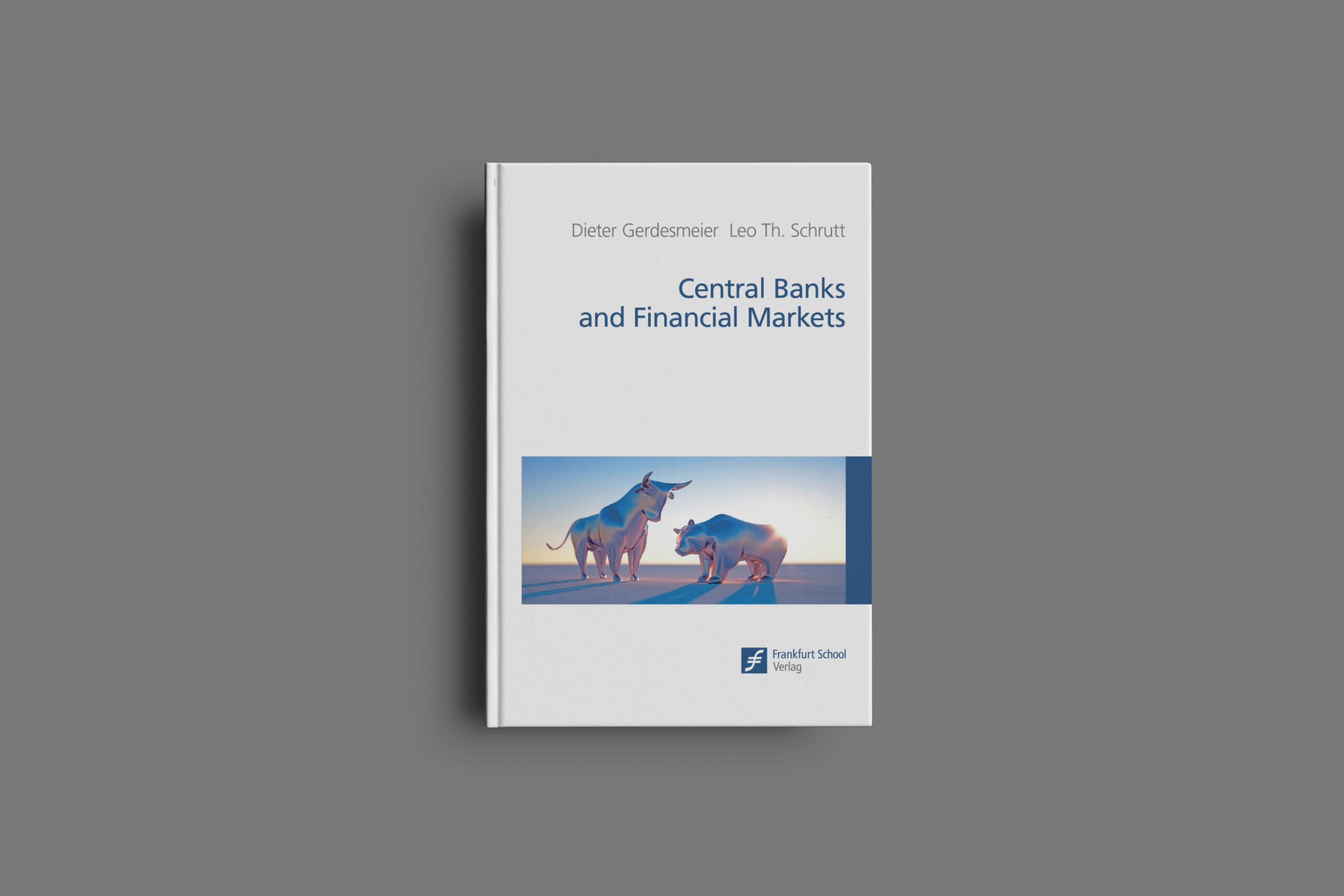
312 Seiten, Paperback, 45,00 EUR
978-3-95647-200-8
Auch erhältlich als E-Book:
Central Banks and Financial Markets
Financial markets exercise an enormous influence over modern economies and it is certainly not exaggerated to say that central banks are among the most important actors in financial markets. At the same time, central banks closely monitor the signals and the overall situation in financial markets, often trying to avoid the worst when the situation becomes fragile.
The structure of this book aims at presenting the key concepts of the financial sphere in an accessible and easy-to-read format. Starting from the very basics, the book discusses markets, instruments, and processes before presenting them in an overall framework. The latter helps to understand how the various parts interact and relate to the whole. Numerous examples and end-of-chapter summaries add to a better understanding of the concepts used.
The book is targeted towards students interested in the world of finance and monetary policy. Both authors have spent decades in the practice of central banking and financial markets and can look back on a long tradition of very successful teaching activities.
Central Banks and Financial Markets
Autoren
Dieter Gerdesmeier
Dieter Gerdesmeier worked in various departments of the Deutsche Bundesbank, before joining the European Central Bank in 1998. Since March 2007, Dieter is acting as Secretary to the Monetary Policy Committee in the European Central Bank. Dieter is mostly lecturing in the Frankfurt School of Finance & Management, where he holds a honorary professorship.
Leo Th. Schrutt
Leo Th. Schrutt is one of leading experts in the field of investment banking in Switzerland. After having worked for the Swiss National Bank, Leo held top management positions at the Swiss Bank Cooperation, the UBS and at the Julius Baer Group, being responsible for Asset Management and Research. At the current stage, Leo holds several positions in various boards and is an advisor to several international institutions. He was lecturing at the University of Liechtenstein and the Fachhochschule in Aarau.
Central Banks and Financial Markets
Session 1: Introduction and Motivation
Part I
Session 2: Financial Markets
2.1 Learning Objectives
2.2 The Financial System
2.3 Functions of the Financial System
2.4 Types of Markets
2.5 Direct and Indirect Finance
2.6 Financial Integration
Key Terms for Review
Key Problems for Review
Session 3: Financial Market Participants
3.1 Learning Objectives
3.2 Financial Institutions
3.3 Commercial Banks
3.4 Shadow Banks
3.5 Central Banks
Key Terms for Review
Key Problems for Review
Part II
Session 4: The Time Value of Money
4.1 Learning Objectives
4.2 A First Look at Interest Rates
4.3 Present Value and Future Value
4.4 The Risk Structure of Interest Rates
4.5 The Term Structure of Interest Rates
Key Terms for Review
Key Problems for Review
Session 5: A Look into the Toolbox
5.1 Learning Objectives
5.2 Some Graphical Tools
5.3 Some Accounting Tools
5.4 Some Statistical Tools
Key Terms for Review
Key Problems for Review
Session 6: Risk and Return
6.1 Learning Objectives
6.2 Calculating Returns
6.3 Measuring Risk
6.4 Portfolio Considerations
6.5 Market Risk and Diversifiable Risk
6.6 Quantifying Market Risk
Key Terms for Review
Key Problems for Review
Session 7: Portfolio Considerations
7.1 Learning Objectives
7.2 Portfolio Analysis
7.3 The Concept of Beta
7.4 Measuring Risk and Return in the Beta Framwork
7.5 Risk and Rates of Return in the Capital Asset Pricing Model
7.6 Other Asset Pricing Models
7.7 Comparing Portfolios
Key Terms for Review
Key Problems for Review
Part III
Session 8: Asset Allocation and Security Selection
8.1 Learning Objectives
8.2 Investment Horizon and Risk Attitude
8.3 Risk and Return Characteristics of some Asset Categories
8.4 Determining the Asset Allocation
8.5 Adjusting the Asset Allocation
Key Terms for Review
Key Problems for Review
Session 9: Bond Markets
9.1 Learning Objectives
9.2 Understanding the Nature of a Bond
9.3 Types of Bonds
9.4 Calculating the Value of a Bond
9.5 Interest Rate Risk
9.6 Reinvestment Risk
9.7 Inflation Risk
9.8 Default Risk
Key Terms for Review
Key Problems for Review
Session 10: Stock Markets
10.1 Learning Objectives
10.2 Understanding the Nature of a Stock
10.3 Calculating the Value of a Stock
10.4 Alternative Measures
10.5 Stock Market Indices
10.6 The Equity Risk Premium
10.7 Fundamental and Technical Analysis of Stocks
10.8 The Graham Approach
10.9 The Dogs of the Dow Approach
10.10 The Bogle Approach
10.11 The Gebert Approach
10.12 Using Financial Leverage
Key Terms for Review
Key Problems for Review
Session 11: Foreign Exchange Markets
11.1 Learning Objectives
11.2 Understanding the Nature of an Exchange Rate
11.3 Explaining Exchange Rates in the Long Run
11.4 Explaining Exchange Rates in the Medium Run
11.5 Exchange Rate Regimes
11.6 A Supply and Demand Framework
11.7 Exchange Market Interventions
11.8 ERM II and the Impossible Trinity
Key Terms for Review
Key Problems for Review
Session 12: Derivative Markets
12.1 Learning Objectives
12.2 Understanding the Nature of a Derivative Instrument
12.3 Types of Derivatives
Key Terms for Review
Key Problems for Review
Part IV
Session 13: The Cost of Capital
13.1 Learning Objectives
13.2 Estimating the Cost of Capital
13.3 Estimating the Cost of Debt
13.4 Estimating the Cost of Preferred Equity
13.5 Estimating the Cost of Common Equity
13.6 Estimating the Weighted Cost of Capital
13.7 A Few Practical Problems
Key Terms for Review
Key Problems for Review
Session 14: Dividend and Dividend Policy
14.1 Learning Objectives
14.2 A Look at the Concept of Dividends
14.3 A Look at Dividend Policy
14.4 Dividend Yield and Dividend Cover
14.5 Dividend Payout and Retention Ratio
14.6 Theories of Investor Preference
Key Terms for Review
Key Problems for Review
Session 15: Mergers and Acquistions
15.1 Learning Objectives
15.2 A First Look at Mergers and Acquisitions
15.3 Types of Mergers and Acquisitions
15.4 Motives Underlying Mergers and Acquisitions
15.5 A Look at the Empirical Evidence
Key Terms for Review
Key Problems for Review
Part V
Session 16: Market Efficiency and Market Anomalies
16.1 Learning Objectives
16.2 Forms of Efficiency
16.3 Market Anomalies
16.4 Behavioural Finance
16.5 Understanding Asset Price Bubbles
16.6 Macroeconomic Effects of Asset Price Bubbles
Key Terms for Review
Key Problems for Review
Session 17: Information Problems in Financial Markets
17.1 Learning Objectives
17.2 Moral Hazard and Adverse Selection
17.3 Implications for Financial Markets
17.4 Mechanisms Alleviating Information Problems
Key Terms for Review
Key Problems for Review
Session 18: Commercial Banks
18.1 Learning Objectives
18.2 Commercial Banks
18.3 On the Macoreconomic Importance of the Banking Sector
18.4 Bank Runs and Banking Crises
18.5 Longer Term Trends in the Euro Area Banking Sector
Key Terms for Review
Key Problems for Review
Session 19: Other Financial Intermediaries
19.1 Learning Objectives
19.2 Pension Funds
19.3 Insurance Corporations
19.4 Mutual Funds
19.5 Sovereign Wealth Funds
19.6 Hedge Funds
19.7 Some Concerns about the Shadow Banking System
Key Terms for Review
Key Problems for Review
Session 20: Central Banks
20.1 Learning Objectives
20.2 European Economic and Monetary Union
20.3 Convergence Criteria
20.4 The Structure of the Eurosystem
20.5 The Structure of the U.S. Federal Reserve System
Key Terms for Review
Key Problems for Review
Session 21: Monetary Policy
21.1 Learning Objectives
21.2 The Costs of Inflation
21.3 Time Lags in Monetary Policy
21.4 The Conduct of Monetary Policy
21.5 The Quantity Theory of Money
21.6 The P-Star Approach
21.7 On the Importance of Money for Central Banks
21.8 Defining Money
21.9 Monetary Definitions in the Euro Area
21.10 Alternative Monetary Policy Strategies
21.11 The Monetary Policy Strategy of the ECB
21.12 The Balance Sheet and the Process of Money Creation
21.13 The Money Multiplier
21.14 Linking Money and Credit
21.15 Taylor Rules
21.16 The Monetary Policy Transmission Process
21.17 Monetary Policy Instruments
21.18 Unconventional Monetary Policy
Key Terms for Review
Key Problems for Review
Part VI
Session 22: Financial Crises and Financial Regulation
22.1 Learning Objectives
22.2 Defining Financial Crises
22.3 Financial Stability and Financial Instability
22.4 Early Warning Models
22.5 The Banking Union in the European Union
Key Terms for Review
Key Problems for Review
Part VII
Session 23: List of Symbols and Abbreviations
Session 24: Multiple Choice Test
Session 25: Glossary
Session 26: References
Session 27: Keywords
Frequently Asked Questions
Unsere Produkte werden in der Regel mit Versanddienstleistern wie DHL oder UPS zugestellt. Die Auswahl des Anbieters hängt von der Lieferadresse und den Versandbedingungen ab, die für Ihre Bestellung am besten geeignet sind.
Bitte melden Sie uns offensichtliche Mängel innerhalb von 14 Tagen nach Erhalt der Produkte. Kontaktieren Sie uns per E-Mail oder Telefon, damit wir Ihnen schnell weiterhelfen können.
Ja, es ist möglich, eine Rechnung auf den Namen eines Unternehmens auszustellen. Bitte geben Sie während des Bestellvorgangs die vollständigen Firmendaten inklusive Name und Adresse an, damit wir die Rechnung entsprechend ausstellen können.
Bitte kontaktieren Sie uns dazu per E-Mail, damit wir die Möglichkeiten für Sie prüfen können.
Als Verbraucher können Sie den Kauf rückgängig machen, indem Sie uns innerhalb von vierzehn Tagen ab dem Erhalt einer Publikation darüber informieren und die Ware innerhalb von vierzehn Tagen nach dieser Mitteilung an uns zurücksenden. Siehe dazu unsere Widerrufserklärung für Verbraucher.
Erweitern Sie Ihr Wissen
Das Forum für Ihren Erfolg
